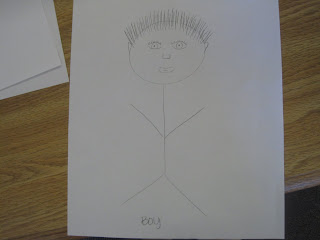My inspiration to creating my headdress was from a Cinderella Book. The Cinderella book showed stories and pictures of Cinderellas across the globe. I got my inspiration from the Polish Cinderella who in the book was wearing a headdress that was like a cap on top but had long pieces that flowed in the back and had flowers all over it. I thought it was really elegant and feminine. At first, I made the cap using paper tissue. Then I cut long strips of tissue and attached it to the cap. To make the flowers, I scrunched pieces of tissue and put them in cupcake holders. I placed the flowers at the end of the strips and around the cap.
You could use this project in a second grade class by introducing different stories of Cinderella around the world and their perspectives of Cinderella. Then the students could try to imitate one of the cultural headdresses worn by Cinderella in another country. The students would be able to learn about the country’s culture and use their creativity.
According to the California Content Standards for second graders:
Key Ideas and Detail:
-Ask and answer such questions as who, what, where, when, why, and how to demonstrate understanding of key details in a text.
-Recount stories, including fables and folktales from diverse cultures, and determine their central message, lesson, or moral.
-Describe how characters in a story respond to major events and challenges.
Craft and Structure:
- Describe the overall structure of a story, including describing how the beginning introduces the story and the ending concludes the action.
- Explain major differences between books that tell stories and books that give information, drawing on a wide reading of a range of text types (first grade)
Integration of knowledge and Ideas:
-Use information gained from the illustrations and
words in a print or digital text to demonstrate
understanding of its characters, setting, or plot.
-Compare and contrast two or more versions of the same story (e.g., Cinderella stories) by different authors or from different cultures.
Monday, February 28, 2011
Sunday, February 27, 2011
Visual Thinking Strategies
Facilitating a discussion about works of art with young students helps those students find meaning in works of art, which enhances their thinking skills. Visual Thinking Strategies encourages participation, self-confidence and a personal connection to art from diverse cultures, times and places. Through visual images, students are able to develop opinions and express them. Students are also able to think independently, but also are able to reflect on the viewpoints of others and work in a group setting where students speculate, argue, debate and build off each others ideas to come to a conclusion. VTS also develops thinking and communication skills. When students develop a connection to art they also develop cognitive skills that are helpful in other aspects of learning.
Picture: Rembrandt:
I asked my three roommates, Kate, Elise and Cate, to look at a piece of art by an artist named Rembrandt. Kate assumed that the man in front was praying because of his figure is kneeling below another man with his head down. Kate also concluded that the men in the red robes were rich and of high class because of their colorful and luxurious clothing and the man kneeling down was poor because of his ragged clothing and lack of shoe on one foot. Then she changed her mind to think that the man kneeling was being punished or asking for forgiveness because the faces of the figures in the background looked sad and full of sorrow. Elise thought that the man kneeling in front is being blessed because his hands are placed on his back and Elise said that she has learned through her Catholic religion that when people are being touched, they are being blessed. Elise also noticed that the man kneeling seemed “dirty” that he is subservient to the other people in the room and needs to be blessed. The man kneeling is also being watched which also happens when someone is being blessed. Cate thought that the man kneeling was being punished because of the scared looks on the other faces in the background of the picture. I thought it was interesting how Elise thought the man kneeling was being blessed while Kate and Cate thought that the man was being punished, which are two different extremes.
Tuesday, February 22, 2011
Headdress research
Meanings and Purposes:
-Ceremonial purposes
-Symbolic meanings (ex. bravery, powerful)
-Hold positions
Materials used:
-feathers
-wooden objects
-shells
-bones
Blog Entry 2/8
The role of art in the classroom is a place where students can express their creativity and respond to artwork. Through drawing, children are able to create symbols and explore visual strategies. At my elementary school, there were art programs for each grade level. My early experiences with art were fun. I remember doing finger painting, using chalk or crayons to depict symbols and drawing cartoons to tell stories. As I got older, I started learning more challenging concepts of art such as oil painting and drawing detailed faces and form figures and creating castles. My favorite art piece that I made in elementary school was a mosaic that I made out of tiny magazine cuttings that formed a rose. All of my teachers were encouraging and enthusiastic about art, which made me feel more comfortable. They always praised my art and never made any negative comments about it, which made me feel more confident about my artwork.
There is an important relationship between art and learning. Through drawing, students are able to learn cognitive skills, such as close observation, concentration and memory. Students are able to find meaning and ideas in the objects they draw. The brain learns through multiple senses and thrives on making sense of new information. Through the learning of art, children are drawn to aesthetics, develop analytical skills and seek out real world applications.
The benefits of art integration includes a safe environment for English learners, development of communication and writing skills, active class discussions and group problem solving. Music and visual arts enhance cognitive systems as well as advance stress-response systems. It also affects emotional systems and cultural understanding. Children are also able to reflect on their experiences through drawing.
My favorite example of how art affects learning that Morgan Appel talked about was the study with medical residents. In a research study, medical residents who were immersed in visual arts improved diagnostic abilities and understanding of non-verbal cues. “Bed-side manners” such as empathy, self-regulation of emotions and stress management were also improved. This experiment proved that art cannot only help younger students achieve their highest potential of learning, but also help adults.
There is an important relationship between art and learning. Through drawing, students are able to learn cognitive skills, such as close observation, concentration and memory. Students are able to find meaning and ideas in the objects they draw. The brain learns through multiple senses and thrives on making sense of new information. Through the learning of art, children are drawn to aesthetics, develop analytical skills and seek out real world applications.
The benefits of art integration includes a safe environment for English learners, development of communication and writing skills, active class discussions and group problem solving. Music and visual arts enhance cognitive systems as well as advance stress-response systems. It also affects emotional systems and cultural understanding. Children are also able to reflect on their experiences through drawing.
My favorite example of how art affects learning that Morgan Appel talked about was the study with medical residents. In a research study, medical residents who were immersed in visual arts improved diagnostic abilities and understanding of non-verbal cues. “Bed-side manners” such as empathy, self-regulation of emotions and stress management were also improved. This experiment proved that art cannot only help younger students achieve their highest potential of learning, but also help adults.
Chapter 3 Question 8 p. 66
Response: First I asked two of my good friends to draw a figure on a piece of paper in any pose. They were very enthusiastic and eager to do so. Tara Iguibashian drew both a girl and a boy both facing forward. Both of their body’s were stick-like but she made both of their faces very detailed, which I thought was interesting. She included details like eyelashes, plump lips, ears and hair. I might conclude from this drawing that Tara believes facial features are very important in distinguishing a person. Tara said she started drawing around age 3 and learned at her daycare. She says, “she’ll never quit drawing!” My other friend Katie Schlobaske also drew a figure facing forward. The figure was waving and looked happy. The figure was also a girl and almost looked cartoon-like. She drew a full body, which included clothes as well. Katie said she started drawing also when she was very young, around 3 or 4 at preschool and says she loves to draw and will always continue doing so. Lastly, I asked my roommate Cate Seago to draw a figure. At first she abruptly declined, but finally she gave in. She drew a stick figure very fast with little detail. She said she thinks she started drawing when she started school around 4 or 5 years old and insists she does not like to draw. She seemed embarrassed and shy about her drawing. I think Cate was a little embarrassed because she was not taught how to draw at an older age or was discouraged to draw in her later years of schooling.
Chapter 2 Response Question 4 p. 39
List of Works:
Multicultural Lesson Plans and Resources
http://www.cloudnet.com/~edrbsass/edmulticult.htm
Learning Resources for Students, Families and Teachers
http://www.studysphere.com/Site/Sphere_101.html
Multicultural Lesson Plans
http://www.dickblick.com/multicultural/lessonplans/
Women’s history- Teacher Resources
http://www.teachervision.fen.com/womens-history/teacher-resources/6678.html
Lesson Plans Page
http://www.lessonplanspage.com/WomensHistoryMonth.htm
Multicultural Lesson Plans and Resources
http://www.cloudnet.com/~edrbsass/edmulticult.htm
Learning Resources for Students, Families and Teachers
http://www.studysphere.com/Site/Sphere_101.html
Multicultural Lesson Plans
http://www.dickblick.com/multicultural/lessonplans/
Women’s history- Teacher Resources
http://www.teachervision.fen.com/womens-history/teacher-resources/6678.html
Lesson Plans Page
http://www.lessonplanspage.com/WomensHistoryMonth.htm
Tuesday, February 8, 2011
Monday, February 7, 2011
Tuesday, February 1, 2011
Subscribe to:
Comments (Atom)















